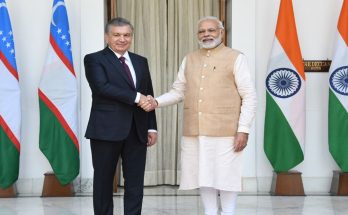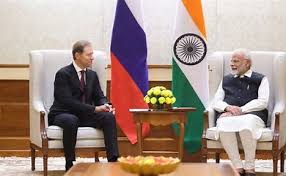 Just a few days before the swearing-in ceremony of India’s newly elected Prime Minister, four Indian Mujahideen (IM) operatives were arrested by the National Investigation Agency (NIA) in Jharkhand. These arrests claim to have unraveled the entire conspiracy behind the Bodh Gaya (July 7, 2013) and Patna (October 27, 2013) blasts. The four arrested include Numan and Taufiq Ansari, Mojibullah and importantly the key IM operative Haider Ali, alias ‘Black Beauty’. Ali – the main accuse in the two blasts – was reportedly recruiting youth in Jharkhand, Bihar and UP before he was arrested. He is, allegedly, the principal link between the Students Islamic Movement of India (SIMI) and the IM, and is therefore considered an important catch after arrests of prominent IM operatives like Tehseen Akhtar alias Monu and Waqas in March 2014, and Yasin Bhatkal along with aide Asadullah Akhtar in August 2013.
Just a few days before the swearing-in ceremony of India’s newly elected Prime Minister, four Indian Mujahideen (IM) operatives were arrested by the National Investigation Agency (NIA) in Jharkhand. These arrests claim to have unraveled the entire conspiracy behind the Bodh Gaya (July 7, 2013) and Patna (October 27, 2013) blasts. The four arrested include Numan and Taufiq Ansari, Mojibullah and importantly the key IM operative Haider Ali, alias ‘Black Beauty’. Ali – the main accuse in the two blasts – was reportedly recruiting youth in Jharkhand, Bihar and UP before he was arrested. He is, allegedly, the principal link between the Students Islamic Movement of India (SIMI) and the IM, and is therefore considered an important catch after arrests of prominent IM operatives like Tehseen Akhtar alias Monu and Waqas in March 2014, and Yasin Bhatkal along with aide Asadullah Akhtar in August 2013.
These arrests have been a great success for the Indian Intelligence and law enforcement agencies. Their sustained efforts in analyzing the modus operandi and establishing links to secure intelligence breakthroughs played an important role in initiating these successes. Consecutive arrests of key IM operatives helped in attaining information and locations of the rest and the security agencies bear credence for acting quickly to nab the others. Significant cooperation from the international community in the form of deportations of important catches, willingness to share information and other counterterror initiatives, also played an important part in aiding these successes.
 While the success of these arrests has come as a major breakthrough in the fight against terrorism, there are a few causes of concern that needs to be addressed. To begin with, despite repeated emphasis on ensuring synergy between the central agencies and state police forces to fight terrorism, on ground coordination between these agencies remains quite dismal. This lack of coordination is manifested by inter-agency competition, confusions over operational jurisdictions and disputes over investigations and custodies of the operatives. For example, the NIA and Delhi Police have been engaged in a series of turf wars over the investigation of terror cases and custodies of operatives – be it a brawl inside the Delhi High Court for the custody of IM operatives Tehseen Akhtar and Waqas, or a two year court case over confusions in probing the Syed Maqbool and Imran Khan case. Along with this, the fight against terrorism has been hindered by the tenuous relationship between the Centre and the States, highlighted by instances where the State has shown reluctance to handover terror cases to the Central agencies. The denial of Central government’s offer to order a NIA probe into the train blasts at the Chennai Central railway station by the Tamil Nadu government, being one recent example.
While the success of these arrests has come as a major breakthrough in the fight against terrorism, there are a few causes of concern that needs to be addressed. To begin with, despite repeated emphasis on ensuring synergy between the central agencies and state police forces to fight terrorism, on ground coordination between these agencies remains quite dismal. This lack of coordination is manifested by inter-agency competition, confusions over operational jurisdictions and disputes over investigations and custodies of the operatives. For example, the NIA and Delhi Police have been engaged in a series of turf wars over the investigation of terror cases and custodies of operatives – be it a brawl inside the Delhi High Court for the custody of IM operatives Tehseen Akhtar and Waqas, or a two year court case over confusions in probing the Syed Maqbool and Imran Khan case. Along with this, the fight against terrorism has been hindered by the tenuous relationship between the Centre and the States, highlighted by instances where the State has shown reluctance to handover terror cases to the Central agencies. The denial of Central government’s offer to order a NIA probe into the train blasts at the Chennai Central railway station by the Tamil Nadu government, being one recent example.
It is largely believed that intelligence is vital for any fight against terrorism. Likewise, the role of the Indian Intelligence agencies has been significant in the continuous successes against IM; however it is not without its shortcomings. It has been generally observed that intelligence sharing among the agencies at the ground level has not been optimum/effective. Allegedly, sharing of intelligence, particularly in organizations such as the Subsidiary Multi Agency Centres (SMAC), has become a paper contribution exercise instead of a platform where agencies share daily information. There is also a lack of a mechanism to filter any poor or inaccurate information that gets integrated in these Centres and subsequently passed on to all agencies. This aspect is problematic since it leads to the creation of a faulty information base.
Therefore, a serious effort to improve inter-agency coordination and cooperation along with a removal of Centre State differences is the primary need. Perhaps, establishment of a federal anti-terror agency, akin to the National Counterterrorism Centre (NCTC), and fully operationalizing the National Intelligence Grid (NatGrid) could be a good start.
Where organizational reforms might prove to be of great importance in ensuring synergy to counter IM’s existing terror structures, reforms in the social sphere would be useful in curtailing the revival of these terror structures in India. The recent arrests of key operatives have created a crucial void in the operational leadership of Indian Mujahideen. It is believed that whenever an organization is in crisis, significant efforts have made by its leaders to revive it. Likewise, it is feared that efforts will be made to revive IM, broadly through a combination of internal and external factors.
Internally, this could be done through a focus on radicalization aiming to renew the indigenous cadres and boost group resilience. This process of radicalization would, most likely, involve – (a) tapping potential individuals or groups dissatisfied with the socio-political context in which they live, (b) translating their real or perceived grievances into extreme ideas, (c) consolidating their views via indoctrination, propaganda, brainwashing, etc., (d) presenting the enterprise as representing an honourable and prestigious response, (e) motivating them to commit acts of terror, and (e) using ideology to reduce moral inhibitors and justify course of action, etc.
To counter such efforts, the government should focus on a novel de-radicalization programme to ensure that the numbers of IM’s homegrown operatives do not rise. An important point to bear in mind is that contrary to the existing narrative of radicalization that charges the poor and economically backward classes as the major constituents of terror organizations, most arrested IM operatives are young, educated, middle-class individuals with a technical know-how. Thus, it would be important to investigate as to why these educated youth are increasingly getting drawn towards terrorism. Maybe the answer to this is the effectiveness of propaganda by the terror ideologues, frustration pushing identity assertion among the Muslim youth, etc. The government should take steps to examine such factors and also conduct careful analysis of increasing activities/alignments of IM operatives with existing terror structures and crime syndicates. For that matter, analyzing the network of front organizations linked to the banned Students Islamic Movement of India (SIMI) could be an effective counter-measure.
Further it would be right to say that although for the time being, IM’s operational capacities in India have suffered a setback, however, the real masterminds still thrive. Most of them are said to be operating from Pakistan. As noted above, the efforts to keep the terror architecture indigenous in character would focus attention on recruitments within India; however, these indigenous troops are usually complemented by a set of trained cadres from Pakistan, which has been the case so far. The government should significantly focus on intelligence to keep track of these trainers and also build greater cooperation with regional countries. In addition to strengthening synergism among the internal and external Intelligence agencies, creating inter-agency task forces with specific objectives will help in bringing out a clearer picture.
In conclusion, these recent arrests have led to a belief in some quarters that it is the end of IM in India. Such beliefs are at best naïve given that the top leaders are still safe in Pakistan. The government should focus on greater inter-agency cooperation and strengthen defenses to a threat that is aiming to rebuild using resources both within and abroad. This could be achieved by: (a) building structures, such as NCTC, to improve coordination among central and state law enforcement organizations as well as internal and external intelligence agencies, and (b) initiating a new de-radicalisation programme along with a careful monitoring of IM’s linkages. Unless the necessary reforms – both in the administrative and the social sphere – are made, the vicious circle of terrorism will perpetuate in the country.
Courtesy: IDSA
Author Profile
- India Writes Network (www.indiawrites.org) is an emerging think tank and a media-publishing company focused on international affairs & the India Story. Centre for Global India Insights is the research arm of India Writes Network. To subscribe to India and the World, write to editor@indiawrites.org. A venture of TGII Media Private Limited, a leading media, publishing and consultancy company, IWN has carved a niche for balanced and exhaustive reporting and analysis of international affairs. Eminent personalities, politicians, diplomats, authors, strategy gurus and news-makers have contributed to India Writes Network, as also “India and the World,” a magazine focused on global affairs.
Latest entries
 DiplomacyOctober 4, 2025UNGA Resolution 2758 Must Not Be Distorted, One-China Principle Brooks No Challenge
DiplomacyOctober 4, 2025UNGA Resolution 2758 Must Not Be Distorted, One-China Principle Brooks No Challenge India and the WorldJuly 26, 2025MPs, diplomats laud Operation Sindoor, call for national unity to combat Pakistan-sponsored terror
India and the WorldJuly 26, 2025MPs, diplomats laud Operation Sindoor, call for national unity to combat Pakistan-sponsored terror India and the WorldJuly 25, 2025When Fire Ends, Diplomacy Begins
India and the WorldJuly 25, 2025When Fire Ends, Diplomacy Begins India and the WorldJuly 16, 2025Operation Sindoor and its Aftermath: India’s Successful Diplomatic Outreach
India and the WorldJuly 16, 2025Operation Sindoor and its Aftermath: India’s Successful Diplomatic Outreach







